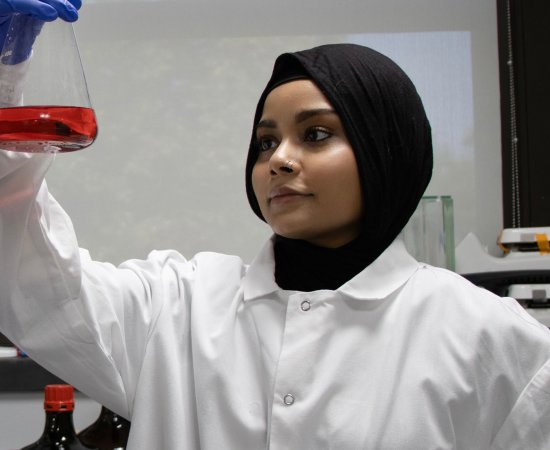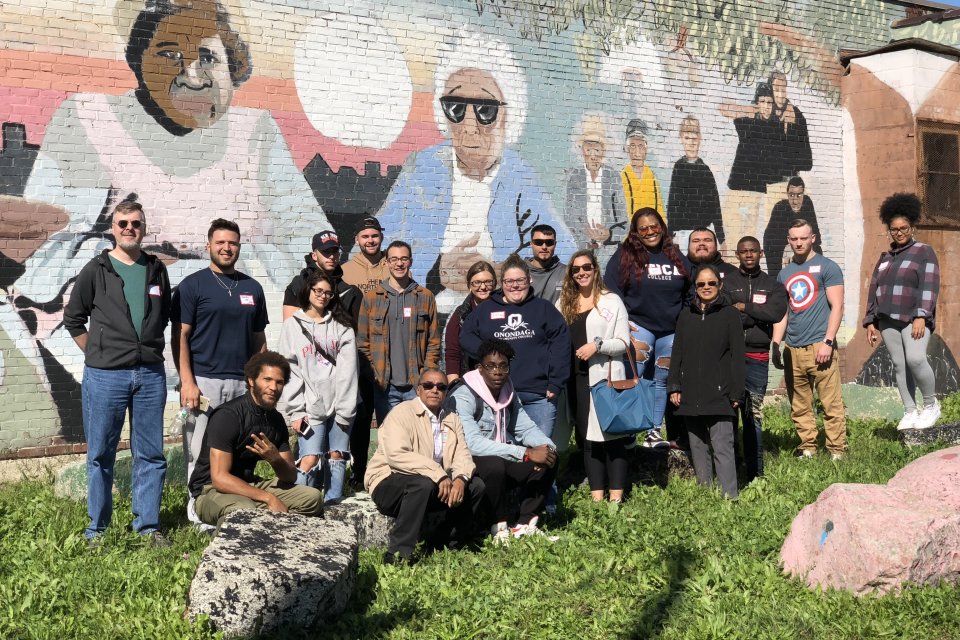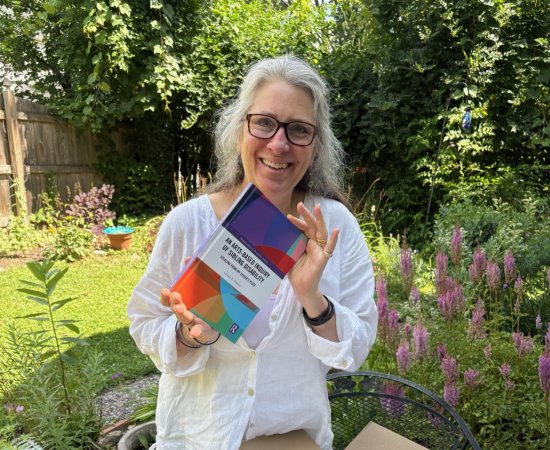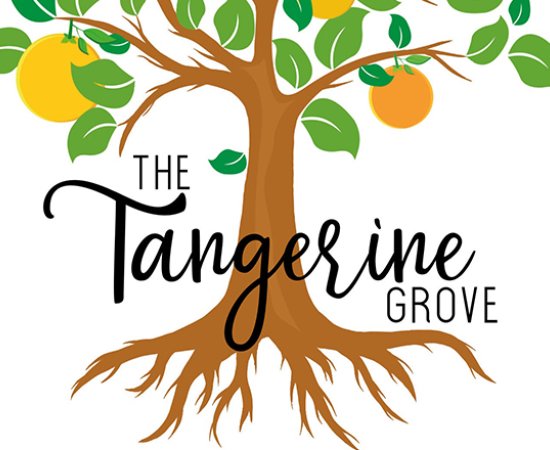
Community Organizing and positive change

To hear about the problems of a community is one thing, but to experience it first-hand, empathize, and find ways to bring about positive change from within the community is exactly what Utica College Professor Dr. Jeff Miller hopes to share with the students of his Community Organizing course.
What began as a 2008 course offered in Senior Seminar in Communication evolved into a topics course in 2012 and 2015, and would eventually become a pillar of the Communication and Social Justice concentration within the Communication and Media major.
“It then became its own stand-alone course named Community Organizing (COM 466) and I have offered it in its current configuration in 2016 and again this year,” said Dr. Miller. “It and its content have evolved over this time and now that it is a required course for students majoring in Communication and Media with a concentration in Social Justice, I am likely to offer it every year-and-a-half.”
The initial idea of the course grew from two experiences, the first of which was Miller’s 2004 Congressional run. It was during this time that he found inspiration in the successful political career of the late Senator Paul Wellstone of Minnesota, who had also been a college professor prior to entering the political realm. In reading Wellstone’s book, “The Conscience of a Liberal,” along with several books about Senator Wellstone, Miller kept running into references to the life and work of Saul Alinsky, an inspirational figure to Wellstone, but a figure whom Miller knew nothing.
“My curiosity grew and I decided to read Alinsky’s biography, where I came to admire Alinsky as a seminal American community organizer and also found mention of time Alinsky spent at Syracuse University in 1965, Soon thereafter, in a casual conversation about my newfound interest in Alinsky with now-retired UC Economics Professor Bill Blanchfield, he immediately recalled Alinsky having visited Utica College as a guest speaker at some time in the late 1960s, and this led me to research this possible visit to campus.”
With the help of the college archivist, Anne Flynn, Miller and she discovered that Alinsky had spoken at Utica College not once, but twice - once in 1965 and again in 1971. The discovery launched what became years of research into Alinsky’s presence and impact in Central New York, primarily at SU where Miller says Alinsky was contracted by the School of Social Work for the year 1965 as a consultant to their innovative Community Action Training Center (CATC).
“In turn, this led me to discover dozens of boxes containing documents, recordings, and other materials related to the CATC that had not been really explored since they were placed in the archives at Syracuse University in 1967. Out of the years I’ve devoted to research on this topic, I designed the current version of COM 466 and have also completed a book manuscript that has been submitted to an academic press.”
In fall 2018, Miller took fifteen students from the Community Organizing class to Roxbury, Massachusetts, to visit the Dudley Street Neighborhood Initiative (DSNI), whose mission it is to empower Dudley residents to organize, plan for, create, and have a powerful voice in public decision-making in their vibrant and diverse neighborhood in collaboration with other community partners. There, UC students saw firsthand how the grassroots, neighborhood-based community development organization empowers its residents, and how the organization’s work took a neighborhood once ravaged by arson, dumping, and disinvestment and gave it a vibrant new life with affordable housing.
In Miller’s opinion, empowering residents to affect change in their own communities is the essence of democratic life and the very best way to help people realize their power as citizens.
“Rather than relying primarily upon a helping hand from charities, government agencies, elected politicians, and human service providers, community organizing aims to empower everyday citizens by developing their capacity to tackle the problems they face in their own communities in ways that they believe are best. This often fundamentally changes the relationship between ordinary citizens and those who typically wield the power to make such decisions on their behalf; it begins with the premise that everyday people deserve a seat at the table and that communities can and should work out their own destiny.”
This shift can also have a profound effect on the people themselves, according to Dr. Miller, who says those empowered citizens can then realize more of their own human potential and forge a stronger and more meaningful sense of community.
“When people know how to take action and have confidence in their ability to bring about positive change, there’s no holding them back. They no longer want to wait for someone else to come around and solve their problems, they’re no longer willing to be told what’s best for them, and they will no longer accept being treated as second-class citizens.”
Miller’s goal is to help students understand what power, political or otherwise, is and what is is not within the context of community organizing.
“I start with Alinsky’s simple definition that power is the ability to act, and that this is power to do, not power over. So, in the context of a free and open democratic society, power means being recognized, if not respected, in the public-decision making process, where most decisions tend to be about allocation of resources, of who will get what.”
Beyond the most recent trip by a Community Organizing class at UC to gain hands-on experience in the power of community action, Dr. Miller points to a trip just two years prior when he took a class to East Brooklyn to meet members of East Brooklyn Congregations (EBC), an organization made up of dues-paying member institutions that include congregations, schools, and homeowners associations. Founded in 1979, over the past several decades, the organization’s accomplishments include the construction of more than 5,000 affordable homes and apartments, the opening of two public high schools, $5 million in park renovations, and countless other neighborhood improvements. There, they sat with Sarah Plowden at St. Paul Community Baptist Church and she told the group how, when she first moved to Brooklyn from the South in the 1960s, there were no street signs in Brooklyn’s Spring Creek neighborhood.
“We take it for granted that every community gets street signs to make it easy to get around, but the City of New York had not bothered to put them up in in her neighborhood. Mrs. Plowden took it upon herself to walk her neighborhood and map its streets, asking people the name of each street and recording it all on three-by-five cards, and once this was done, community members demanded and got a meeting with the head of the city department responsible for street signs. The meeting was to take place in Mrs. Plowden’s Spring Creek neighborhood and the city bureaucrat was given a street address but when he arrived that evening, he soon realized that without street signs he had no idea how to find the location of the meeting and began to worry that he would end up lost at night in an unfamiliar, mostly black, neighborhood.”
The city official eventually found the correct address and met with residents, Miller explains, and those residents demanded that their neighborhood be given street signs like any other neighborhood. The official’s experience before he even met with the residents made their point for them, and the signs were soon installed.
“Mrs. Plowden and her neighbors, by organizing themselves - doing the work of mapping the streets, determining who in city government held the power to give them what they wanted, and planning and successfully inviting that bureaucrat to a community meeting (and intending for him to experience a few nervous minutes in their shoes, lost in the unmarked streets of Spring Creek) - acquired for themselves the power necessary to persuade a public servant to treat their neighborhood with the same respect, dignity, and recognition, as any other neighborhood. And they got the street signs that they had every right to deserve. But that is all easier said than done, and the [UC Community Organizing] course explores the difficult work of building that collective power through community organizing, especially in the face of the inevitable opposition of those who would rather just leave things as they are.”
The path to progress starts with the knowledge and acceptance of where we as a society fall behind, and it’s through the experiential lessons of the Community Organizing course and associated trips like the ones to Roxbury and East Brooklyn that Miller hopes students gain first-hand, real-world experience on what they can do to make things better.
“I believe that if we are to progress as a society, to share in all of the benefits of democracy, and to create a more equitable, fair, and just society, then we must become aware of the existing inequality and discrimination and do the hard work to eliminate it. Our communication practices inevitably embody our values and so, if we ever hope to realize the full promise of the Constitution, we must make social justice central to the way we communicate with one another, whether it’s in face-to-face interaction, or in the way we form and govern our communities, or in the role and uses of social and mass media.”
UC's Communication and Media Major (CMM) offers nine concentrations, including one in Communication and Social Justice. The innovative program combines a foundation of communication courses with courses from a variety of other disciplines as preparation for students who wish to become advocates for human rights, civil rights and environmental causes, community organizers, social workers, alternative media workers, or lobbyists, as well as those considering graduate study in law, social work, or the social sciences.
More Stories


Big little sister

Local Organizations Give to Utica University’s Tangerine Group Food Pantry
I would like to see logins and resources for:
For a general list of frequently used logins, you can also visit our logins page.
